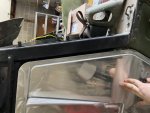Wood and fiberglass will both absorb the gluing agent into the fibers, effectively becoming one with the fibers. You have a much stronger bond because of this, and the base materials are strengthened with the additional bonding agent absorbed into the fibers.
When gluing two pieces of metal together you only get a surface bond, no penetration. The bonding/gluing agent doesn't soak in at all, and the only hold is the microscopic imperfections in the surface of the metal. It doesn't alter the properties of the base material like it does with the wood or fiberglass.
Lets use glass as an example. If you laminate glass, it doesn't make the glass particularly stronger than identical thickness of glass that doesn't have the lamination in the middle. Glass gets laminated for safety reasons, to control what happens to the glass shards when it gets broken, not to increase it's resistance to damage or change other physical attributes. Also one layer getting broken doesn't necessarily affect any other layers, as that layer breaking absorbs energy lowering the amount of energy going to other layers. Also true in composite armors, multiple layers (often of different materials) laminated together to absorb and dissipate energy, but not necessarily any stronger than if you just made the entire thickness of a single layer of the strongest material in the lamination.
The main advantage I could see to having a laminated metal door is to reduce noise. The glue/bonding agent would absorb a lot more vibrations/rattles than a solid piece would, therefore making it quieter overall. Whether that makes any real difference in practical application though would remain to be seen.








